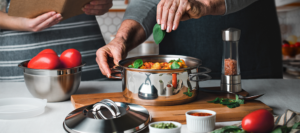Cast iron cookware has been a staple in kitchens for centuries, celebrated for its durability, versatility, and excellent cooking performance. This guide explores the benefits, maintenance tips, and usage techniques for cast iron cookware, helping you maximize its potential in your kitchen.
What is Cast Iron Cookware?
Cast iron cookware is made from molten iron poured into molds, resulting in heavy, durable pots and pans. Available in both enameled and traditional (bare) finishes, cast iron cookware is prized for its ability to retain and evenly distribute heat.
Benefits of Cast Iron Cookware
1. Exceptional Heat Retention: Cast iron heats slowly but retains heat exceptionally well, making it ideal for slow-cooking, frying, and baking. This property ensures even cooking and consistent results.
2. Versatility: Cast iron cookware can be used on various heat sources, including gas, electric, induction stovetops, and even open flames. It’s also oven-safe, making it suitable for a wide range of cooking methods.
3. Durability: With proper care, cast iron cookware can last for generations. Its robust construction makes it resistant to damage, warping, and wear.
4. Natural Non-Stick Surface: Over time, bare cast iron develops a natural non-stick surface through a process called seasoning. This makes it an excellent choice for cooking foods that tend to stick, such as eggs and pancakes.
5. Iron Fortification: Cooking with cast iron can add a small amount of iron to your food, which can be beneficial for those with iron deficiencies.
Caring for Cast Iron Cookware
Proper maintenance is essential to preserve the performance and longevity of cast iron cookware. Here are some key care tips:
1. Seasoning: Seasoning involves coating the cookware with a thin layer of oil and heating it to create a protective, non-stick layer. To season, apply a thin coat of vegetable oil to the entire surface, then bake it in the oven at 375°F (190°C) for about an hour. Repeat this process as needed to maintain the non-stick surface.
2. Cleaning: After each use, clean cast iron cookware with hot water and a stiff brush or sponge. Avoid using soap, as it can strip away the seasoning. For stubborn food residues, use coarse salt as an abrasive. Dry the cookware thoroughly to prevent rusting.
3. Storage: Store cast iron cookware in a dry place. To prevent rust, avoid stacking wet or damp cookware. If stacking is necessary, place a paper towel or cloth between pieces to absorb moisture.
4. Re-Seasoning: If the seasoning wears off or the cookware develops rust, re-season it by scrubbing away any rust, applying a thin layer of oil, and heating it in the oven as described above.
Using Cast Iron Cookware
Here are some tips to help you get the most out of your cast iron cookware:
1. Preheating: Always preheat cast iron cookware before adding food. This helps ensure even cooking and enhances the non-stick properties.
2. Cooking Oils: Use oils with high smoke points, such as vegetable oil, canola oil, or grapeseed oil, to prevent the oil from breaking down and affecting the seasoning.
3. Cooking Techniques: Cast iron is excellent for searing, frying, baking, and slow-cooking. It’s particularly well-suited for recipes that require high heat or long cooking times, such as stews, roasts, and cornbread.
4. Avoiding Acidic Foods: While well-seasoned cast iron can handle some acidic foods, prolonged exposure to acidic ingredients (like tomatoes or vinegar) can strip the seasoning. Use enameled cast iron for these dishes if possible.
Conclusion
Cast iron cookware is a timeless addition to any kitchen, offering unmatched durability, versatility, and cooking performance.
By understanding its benefits, maintaining it properly, and using it effectively, you can enjoy the many advantages of cast iron cookware for years to come.





